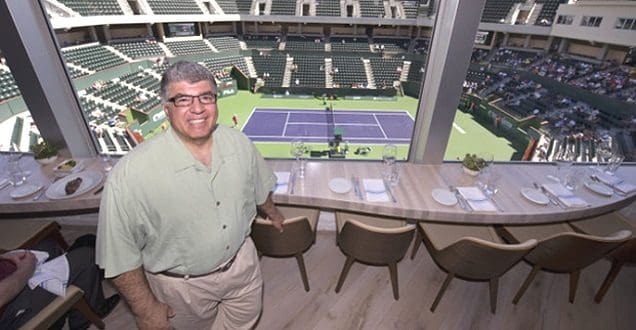A native Coloradan, Lee Morcus graduated from the University of Denver with a Bachelor of Science, Business Administration degree majoring in Hotel and Restaurant Management. Morcus has devoted his life to the food and restaurant business on a corporate level, as a franchise owner, developer and entrepreneur, and as an independent restaurateur. He always knew he would be an owner, coming from a family of business-oriented entrepreneurs.
Morcus and his father opened their first restaurant, Kaiser Grille Palm Desert in 1992 and have grown the family business to seven restaurants. The Kaiser Restaurant Group includes several brands: Kaiser Grille, Prime Chop House, The Grind, Jackalope Ranch and the Hog’s Breath Inn. Morcus’s latest venture is the La Quinta-based, Figue Mediterranean Restaurant and The New Chop House at the Indian Wells Tennis Garden.
Morcus serves on several Boards and also has chaired several including the Convention and Visitors Bureau (5 years) and the Coachella Valley Economic Partnership (4 years). He was recently inducted into the prestigious La Chaine des Rotisseurs and Les Amis d’Escoffier. Lee runs the Kaiser Restaurant Group with his father Kaiser and siblings Eric and Sue. LMLQ, LLC. and Figue are separate entities.
KB: Lee, you’ve said you were “born into food.” Did you always know you wanted to be a restaurateur?
LM: No, not always, but I was always around food and then food and beverage. Whether it was my grandfather’s farm, my mother and grandmother’s Kitchens, my father’s supermarkets or his hotels, I was always around and enjoyed being around food. I have been told that I was easy to babysit as a toddler—they just put me in my grandmother’s kitchen while she cooked and I would watch her cook from my perch on her kitchen step stool. My fondest childhood memories are of being in the kitchens, farm, grocery stores and hotels. I was not just hanging out—they put me to work, and it was fun!
KB: I so enjoyed hearing about your childhood memories of being in your grandmother’s kitchen watching her bake bread and make her own yogurt. How old were you when you learned how to cook?
LM: That is a difficult question to answer, I remember standing on wire milk crates in my grandfather’s Butcher shop. I was maybe 4 or 5? I ground hamburger, raked saw dust floors, scraped bone dust from meat after we cut it on a band saw in the butcher shop. By the time I was maybe twelve, I could make my own meals—not all the time and certainly not sophisticated, but I was cooking and enjoyed it and enjoyed creating and experimenting. I still don’t precisely follow recipes, I use them for inspiration.
KB: So you’ve really come by this honestly. From the family butcher shop to your father’s grocery stores, food has always been an integral part of the way you live your life. And I understand you worked as a hotelier for quite some time as well. Tell me about that experience.
LM: My father started developing hotels in Vail, Colorado in the mid 1960s. So, I was assigned the work that no one would do. I started emptying garbage, cleaning swimming pools, cleaning parking lots and sidewalks, carrying clean and dirty laundry, vacuuming, etc. I was probably 10 years old. Summer jobs and on school break, found me working for my Dad, and I quickly gravitated towards food and beverage. I was lucky, we had world class French chefs that were incredible—old school tough, passionate and yet very talented. I started scrubbing their pots and pans—the very bottom of the “food chain.”
Eventually I worked for Marriott Hotels after I graduated from college and was a member of their opening teams—when they opened a hotel or remodeled restaurants and other Food and Beverage outlets, I was part of one task force that would work on property 3 to 4 months in advance opening the outlets: hiring, training, operations, local policies, procedures, etc. I would work for a few months after opening and they would transfer me somewhere else to do it again.
KB: And what brought you to the desert from Chicago?
LM: My father bought a second home in the Desert in the 1970s. I was in Chicago. In 1991, Dad called me and said he was going to develop a restaurant in the Desert (he was bored and needed a challenge). I asked him if he was nuts—I was totally against it. We have one season a year to generate income—at least in Vail and the other ski resort towns where he had businesses, we had winter and summer seasons. He was not interested in my objections; he wanted me to invest…he knew where it would ultimately lead. I wrote him a check and told him that it was so I could keep an eye on him. Kaiser Grille Palm Desert was an instant success. By 1994, I was spending more time in season in the Desert than I was in Chicago. By 1996, I decided I wanted to be here full time.
KB: When did you move to the Desert full-time? Did you experience any culture shock after so many years in Chicago?
LM: I made the full break from Chicago in 1998 when I sold my restaurant there. We then developed Kaiser Grille Palm Springs—another instant success. Culture Shock? No! Culture transition? Absolutely. I lived downtown in Chicago and lived a true urban lifestyle, it was a blast. I was a young single guy with a little cash in his pocket. The desert is more serene; climate adjustment was an issue. I remember when I visited Chicago over Labor Day after my first full summer in the desert, how cold Chicago was—50 degrees! For me, it felt like 20 below. I froze my tail off and my friends were laughing at me, because when I lived in Chicago, that sort of weather was nothing.
KB: I understand you currently run the family business, Kaiser Group. What’s it like working with your siblings? [Kate previously interviewed Lee’s younger brother, Eric Morcus]
LM: It is great being with and near family. Obviously, in business, we don’t always agree on everything, but we have the same goals professionally. It is great being close, and I also appreciate seeing my nieces and nephew here growing up; it’s great. As long as they remember that I am the CEO, we get along fine! I’m joking, of course.
KB: What led you to start Figue? I understand it’s a bit of a departure from your other restaurants—a more sophisticated and urbane experience, and an unabashed nod to your Mediterranean heritage. Tell me a little about this new venture.
LM: The restaurant scene in the desert is a bit homogenized. I was bored doing the same thing over again and competing with all of the other restaurants that are all running the same basic format. Nothing against this—these restaurateurs are terrific and many are my friends. It is more about me and blazing a new trail, a trail that is unique, relevant, and hopefully represents the future of food, finer dining and continually evolving tastes. We have an amazing modern building, beautiful and architecturally stunning and significant. I knew that I wanted to do a Mediterranean restaurant. I felt and still do, that the desert is ready and wants a finer dining restaurant without pretense.
The design charge was to take this beautiful modern building that was hard, cold, and decidedly masculine, and add grace, softness and warmth by adding feminine influences, texture, richness, depth, etc. I told our design team that we need to transport our guest away from daily life to the Mediterranean and create an environment that seamlessly links, blends and integrates the modern and future with our past. I wanted something that would be a unique and incredible experience in NYC, LA, San Francisco, Paris, Marseilles, Napa, Bordeaux, etc. We are food focused. Period! Simply the finest of ingredient without compromise.
KB: The design, as you mentioned, is integral to your vision for the restaurant. How do you envision the design of Figue impacting the overall dining experience? Are there different indoor and outdoor areas, or simply one main communal space?
LM: We wanted to create multiple environments where our guests have choices and varied experiences. We just did not want to develop a bar and dining room, although we have both. I have a profound distaste for restaurants that have a sea of tables and chairs that all look the same with no visual interest or sense of style. We have two distinctly different patios at Figue: one, the Casbah, is completely closed by sheer curtains and feels more like a cool outdoor living room. The second patio is covered and boasts fabulous views of the mountains and desert. It feels more like a outdoor dining room with Carrera marble tables, a small fire pit and these amazingly beautiful and incredibly comfortable split seat Acacia wood chairs.
We created seating around our charcuterie/mozzarella bar where guests are entertained while watching our culinary team slice amazing imported prosciuttos, Spanish Bellota ham, and meats from a beautiful, imported Ferrari red handcrank meat slicer. Guests can watch our team utilize these amazing mozzarella and other cheeses to create interesting small, plates, panini and salads. It is an incredible experience.We probably have 50 different kinds of olive oils, at least 25 different balsamic vinegars, another really cool things to provide flavor, taste and nutrition.
Our dining room has several different table materials, and seven different types of seating. The goal was to create an environment where every dinner, every table provided a different and wonderful visual anesthetic experience. With linen curtains throughout to create an air of intimacy, warmth, privacy, mystique and intrigue, we included large sharing and chefs tables were strangers become friends by the end of their dinner. But there are many cozy little intimate areas for smaller parties and large groups alike. There are also areas for larger parties of six, eight, ten twelve or more, as well as areas that have a higher energy, are more centralized for those who want to see and be seen. We wanted to create something that’s more than just dinner out in another restaurant. We designed our dining room in a way that we could do parties on a larger scale with a high degree of privacy and intimacy yet not be completely isolated from the authentic Figue experience what is common in traditional banquet rooms.
KB: And you are importing much of the food and all of the flours. Why is that?
LM: It’s really not about importing; It is purely about quality and ingredient integrity. We have commitment to food without compromise; our goal is to source and procure the finest food and ingredients in their purest and most ripe, peak and authentic form. Imported is not always better, particularly when it comes to agriculture. We source produce from small organic and sustainable farmers, farmers markets, and our produce vendor knows where and how to source premium ingredients at their peak. Our farmers and ranchers are typically small, organic, sustainable, holistic, and treat their animals humanely and with dignity. They sell their product at a premium and it is the responsible thing to do. Quite simply, for us, it’s just about better food. It’s about quality, authenticity, integrity, and sourcing food that is absolutely at its peak. Better food tastes better; better food is more nutritious. The people we work with to source our ingredients are as passionate about what they do as we are about what we do.
We import European flours because they’re better flours; they make better breads, better pastas (make many of our pastas by hand in house), pizza doughs, breads, pastries and desserts. The European flours are healthier and it taste better. Their wheat have not been crossbred and utilize hybrid strains like the American wheat industry has done for years. Granted, the American wheat industry, by creating hybrid strains and crossbreeding wheats, has created higher crop yields that are more drought and pest resistant than ever before. It’s not a bad thing, but we believe the quality and product integrity has been compromised by this process.Here are other examples of our commitment: We source our lamb in whole animal form from a small Pennsylvania farm that is absolutely committed to holistic, sustainable, humane and organic farming. They care about the ethical treatment of their animals. We buy the lambs whole and butcher them in house. Thomas Keller, the famed chef, is a partner in the farm. When you see Mediterranean seafood on the menu or Mediterranean fish, it is a true Mediterranean fish and not some distant cousin or close substitute. It is about food and purity at its absolute peak. This is where the greatest flavor, taste and nutritional value lies.
KB: What’s your favorite and least favorite food?
LM: I love food. It will be very hard for me to select favorite. I won’t even try. My mother, grandmother and father prepared some amazing Lebanese meals over the years. I really like and appreciate exploring and experiencing and trying new ingredients taste and flavors and cultures. I am a strong advocate of producing food that is clean and healthy and grown in exactly the way mother nature intended. This is why our menus are ever evolving—we want to take full advantage of the bounty at its peak. For us, it’s about the ingredients and the ingredients change daily and with the seasons. The food at Figue continually evolves and changes. Regarding what I don’t like, I am not a big fan of tripe. And I generally shy away from soft drinks and fast food.
KB: When you’re not busy transforming the dining experiences of Greater Palm Springs, what do you enjoy doing in your spare time?
LM: I read a little and I like to play golf. I love to ski although I haven’t done much skiing in the last few years, and then there’s travel—to truly experience cultures, one needs to eat the foods in and with and of those cultures. Fortunately this includes wines and spirits of those cultures as well. I like to see what is innovative within my industry and that is a broad brushstroke encompassing farming, fishing, wineries and much more. It is not just about dining at cool restaurants; it is about living and experiencing life!
KB: And what is it that you love most about Palm Springs?
LM: There is much to love. Life is simple. Life is serene. There’s an incredible wealth and I am not talking about financial wealth. I am talking about people with human wealth—hearts and minds. Also, we’re close to the beach; we have some culture here and easy access to more. It’s a great place to travel from. It’s home.
If you or your organization would like to be interviewed for a Palm Springs Spotlight, please contact PalmSprings.com.







Lee,
When are you opening again? Called and got a message that you would be open after Labor day, but you were not. We went to Kaiser Grill and met your brother Eric.
I wish you a GREAT season and hope to make my grape leaves for you and Francious soon. I know you will love them.
Take care, Lynda Samen “Safe~T~Sleeve”